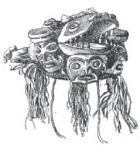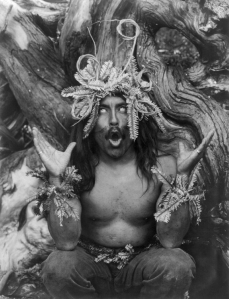Dancing at Time Zero: Kwakiutl Secret Dance Societies
We previously looked at the symbolic structures that organize every aspect of social life and identity of the Native Americans of the Pacific Northwest, including the Tlingit, Haida and Tsimshian peoples.
In these societies, social identity is articulated through a complex symbolic vocabulary of hereditary emblems or crests, perhaps best known through the extraordinary visual art of the region, including totem poles.
These crests exemplify legendary or mythological forms associated with families or peoples, and may be used to declare public identity, social status, or rights and privileges. As we considered in an analysis of the mythology of the region, these crests are not just visual, but encompass a rich oral tradition of stories and legends that record everything from the birth of the sun to historical movements of people. Some of these stories, such as the Tlingit story of their exodus out of Glacier Bay, contain a mix of mythological symbols and historical facts.
Another way in which the system of crests may be deployed is through ceremonials, such as the famous potlatch celebrations honored by all of the peoples thus far mentioned. These days-long ceremonies are used to commemorate events of great importance, such as rites of passage or changes in status.
The family throwing the potlatch offers a great feast and gives mighty gifts. Slaves may be freed or sacrificed.
This picture shows a beautiful train of enormous food vessels, carved to depict the Sisyutl, or double-headed serpent. It was used to wheel in vast quantities of food during such feasts.
In this post, I would like to give attention to a particularly fascinating expression of this symbolic social economy, the winter dance rites of the Kwakwaka’wakw, otherwise known as the Kwakiutl, a people indigenous to British Columbia.
During the spring and summer months, the Kwakiutl used a form of social organization that is substantially similar to other groups in the Northwest, including the use of clan crests and potlatches. However, during the long months of autumn and winter, the regular social order was suspended, and the entire village entered into a complementary period, structured by alternative ritual identities. This period served as the spiritual counterpart to their ordinary economic identities of the summer months.
While summer was a time of food gathering and production, during the winter months the men would gather in secret initiatory societies, where they spent long periods preparing for intricate ritual dances. The men of these secret societies used different names during this season; names that were previously bestowed by spirits during shamanic ceremonies.
As Franz Boas observed in his definitive ethnography of Kwakiutl ceremonials, “It is clear that with the change of name the whole social structure, which is based upon the names, must break down. Instead of being grouped in clans, the Indians are now grouped according to the spirits which have initiated them.” [1]
The summer period was called the ba’xus, which Boas translates as “profane,” while the winter ritual period was known as ts’e’ts’aeqa, meaning “the secrets.”
According to the religious historian Sam D. Gill, the winter period was regarded as existing outside of time itself. Ts’e’ts’aeqa constitutes a timeless period that recapitulates the original time outside of time, that zero hour from which all creation is projected, and which is the true domain of mythological forms.
Please take a moment to click on and enlarge the magnificent picture to the right, taken by the great ethnographic photographer Edward Curtis. It shows a group of Kwakiutl men in dance regalia in a winter clan house, and conveys a striking sense of the power of these ceremonies. Note the three men crouched in the center, wearing bird masks that extend some seven feet or more in length. Masks of this kind may be viewed today at the Museum of Anthropology in Vancouver.
We have every indication that the ritual effort of the winter ceremonials induced long, sustained periods of trance, supporting an ongoing period of profound relationship with the deepest levels of human consciousness.
Masked ritual dances are associated with shamanic cultures in their entire domain, stretching from Tibet and Siberia across the Bering Strait, and reaching all the way down to Tierra del Fuego in South America. However, the Kwakiutl dances are striking in the degree to which they regularly reorganize their society in terms of a complementary set of social symbols which derive not from the ordinary daylight world of labor and production, but from the nighttime realm of the unconscious, inhabited by self-luminous dream images.
Like most ritual masked dances, the Kwakiutl dance celebrations reenacted mythological events, and the participants identified with the mythic forms they depicted. Just as the priest at mass is viewed by Catholic theology as literally recapitulating the mystery of incarnation through transubstantiation, and just as the Haitian Vodouist literally becomes a vehicle for the loa, so too in the Kwakiutl there is no separation between the dancer and the spiritual forms they embody.
These rituals sometimes articulated mythologies of great violence and power, such as the notorious Hamatsa cannibal dances. Martha Padfield has written an excellent brief analysis of the Hamatsa dances in her Cannibal Dances in the Kwakiutl World, and Franz Boas has treated the topic at some length in the book cited above.
The Hamatsa myth that forms the basis for the dances has been recorded in several versions, frequently involving an initiate who travels outside the village (i.e., outside of the normal social order) to the dwelling place of a malevolent being named BaxbakualanuXsi’wae. The hero may kill the spirit and steal its powers, or receive initiation, or some combination of the two.
The version of the story that ties directly to the ceremonial tells of a young man named Q’uo’mkilig’a who goes into the woods to find cedar bark, but when he is alone he is possessed by a fearsome being named ho’Xhok”. When he fails to return to his village, his friends and family search the woods and find him lying deep in trance.
His father takes him to a shaman’s home for treatment, and four days later, the boy wakes from his ordeal, having received the name QoaLqoa’oe. Immediately upon waking, QoaLqoa’oe leaps up in a savage state and tries to devour his father. There is a frightful commotion, and villagers rush in to surround him, trying unsuccessfully to subdue him. Their ropes cannot hold him, and the villagers flee the hut in terror, leaving him to sing strange new songs. For some time he runs amok, trying to attack and bite the villagers, until at last he recovers his senses. [2]
This myth reflects the tension between the shamanic initiatory crisis, which also takes the form of a spontaneous and prolonged mental breakdown, and ordinary forms of social interaction. Shamanic forms of spirituality are idiosyncratic and highly personal, and often express themselves in opposition to the social order. The Tlingit shaman, for example, was buried outside of the village, and was the only person who could be directly paid for work [3].
In many traditional societies, we find a tension between the personal visionary experience exemplified by the shaman and the organized ritual world of the priest. In contrast to the shaman, the priest’s primary function is not to bring about a psychological breakthrough, but on the contrary: they serve to integrate individuals into the proper social order. The priest’s job is to make sure individuals stay in their role, so they can perform their necessary function for the good of the society.
Shamans have always been viewed with profound ambivalence, and regarded as marginal figures in the societies in which they operate. In many cultures, their career could be reliably expected to end with their violent death, as they were routinely killed by angry relatives of those who died by illnesses that the shaman was believed to have caused.
In the Hamatsa dance, the wildman figure enacts the return to the village by dancing wildly in the center of a circle of men who try to restrain him. The wildman acts out with varying degrees of literal-mindedness, biting and attacking members of the audience, drawing blood and sometimes biting off chunks of flesh. In some cases, audience members who lost a bit of flesh were confederates who had been compensated in advance, in other cases they were just unlucky.
An element of real risk intensifies rituals of this kind, and there is some debate regarding whether or not people were actually killed and eaten during the Hamatsa dances. However, Franz Boas, whom I regard as an extremely reliable authority, was confident that this did in fact occur. In one chilling account, he records:
I received another report of the killing of a slave. A female slave was asked to dance for the ha’mats’a. Before she began dancing she said: ‘Do not get hungry, do not eat me.’ She had hardly said so when her master, who was standing behind her, split her skull with an ax. She was eaten by the ha’mats’a. [4]
It does not seem at all implausible that this should have occurred. We know for certain that slaves were sometimes killed for ceremonial purposes in the region, to gratuitously demonstrate wealth in a potlatch or so they could be interred beneath the foundation of a new lodge. In many aboriginal societies, mythological forms are played out with a deadly degree of seriousness.
References
Photography: Many of the wonderful photos Edward S. Curtis took of Native Americans were published in a twenty-volume collection entitled The North American Indian, which is now in the public domain. Northwestern University hosts an online collection of the photos.
1) Boas F. and Hunt G. The Social Organization and the Secret Societies of the Kawkiutl Indians. from The Report of the U. S. National Museum. Government Printing Office. 1897. p. 418.
2) Boas and Hunt, pp. 407 ff.
3) Oberg K. The Social Economy of the Tlingit Indians. University of Washington Press. 1973.
4) Boas and Hut, p. 420





Leave a comment